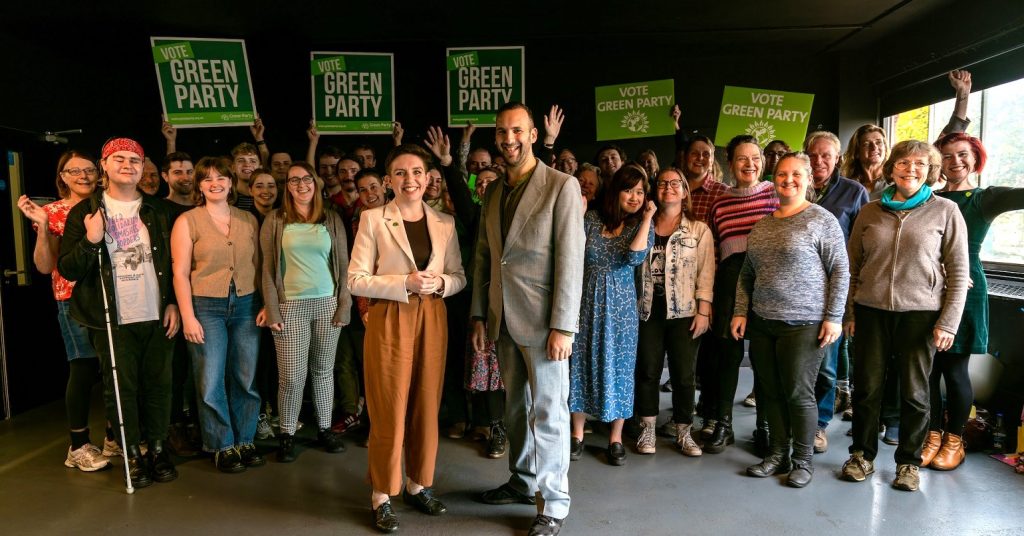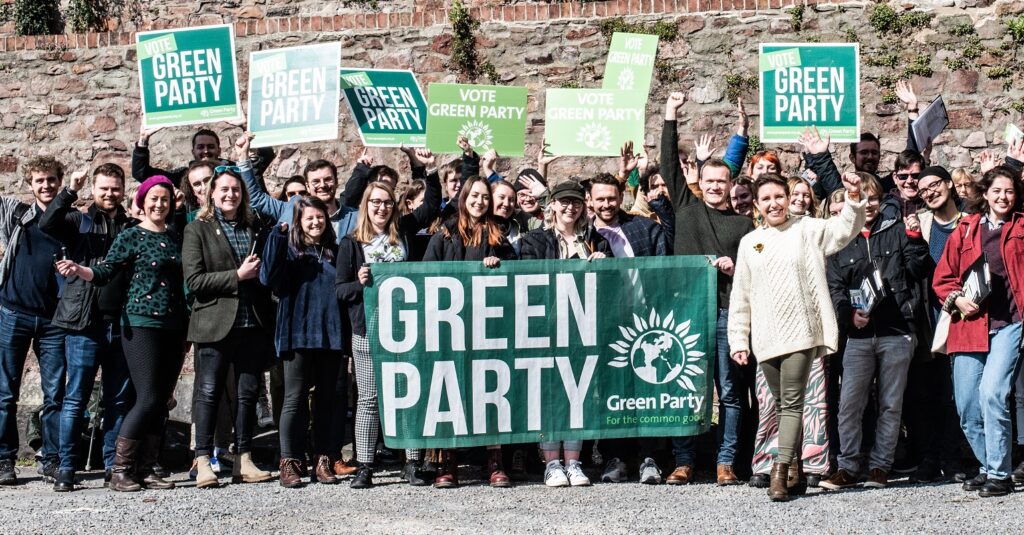5 things to look out for at Green Party conference

Members of the Green Party of England and Wales are meeting in Brighton for their autumn conference this weekend. This could be the party’s final conference before the next general election. As such, it is likely one of the last windows to take a peek into the party before the campaign kicks in.
In light of this, here are five things to look out for at the Green Party’s conference this weekend.
1. The death of ‘progressive alliances’?
The notion of a ‘progressive alliance’ entered the mainstream conversation in left of centre circles after the 2015 general election. Caroline Lucas and Jonathan Bartley made it a central plank of their pitch to the Green Party membership when they stood for the co-leadership in 2016. The argument was that in 2015 a number of seats were narrowly won by the Tories as a result of the left of centre vote being split. If instead of every progressive party standing, just one did, the hope was that the number of Tory MPs could be whittled down.
At the 2017 general election, a number of local Green Parties opted not to stand candidates in a bid to prevent the Tories from winning seats. Two years later, the ill-fated ‘Unite to Remain’ pact was agreed between Plaid Cymru, the Greens and the Liberal Democrats. In dozens of seats across England and Wales only one of the three parties stood a candidate.
In light of the escalating cooperation in the previous two elections – concurrent with pacts agreed formally or informally at a local council level – one might expect that the Greens would be looking to explore this further.
Not so, it seems. At this year’s conference, members will debate a motion which would give the party’s central operation the power to force local parties to select candidates. While the motion does not reject the principle of alliances outright, it nonetheless seeks to prevent local parties from engaging in disaggregated local agreements.
This motion has been prioritised by the Green Party Executive. In practice, what this means is that is highly likely to be debated and voted on at the conference – ahead of other motions which came before it in the prioritisation ballot. It also has the backing of influential figures in the party – including the party’s co-leader Adrian Ramsay, the peer Natalie Bennett and former MEPs Molly Scott Cato and Gina Dowding.
What will happen when the motion comes to conference floor is anyone’s guess. With no candidate in the last two leadership election cycles pushing the issue and no recent vote at conference, there has been no test of the membership’s appetite for electoral alliances in some time.
Mutterings within the membership give some indication. There is disquiet among three camps.
First, there are those in areas who have engaged full throttle in local pacts – places like Oxfordshire, where some members see pre-election arrangements with the Liberal Democrats as central to why there are now no longer any Tory majority councils in the county, when less than a decade ago all but one were run by the Tories.
Second, there are those who are concerned about the financial implications for local parties. Some local parties span multiple parliamentary constituencies with a small membership. In these cases, the prospect of being instructed to field candidates means finding the cash to fund several deposits at £500 a pop is daunting. There is additional upset at this particular moment, as funding from the central party is being reduced.
And finally, there are those opposed to what is perceived as a heavy-handed centralising move. Irrespective of people’s thoughts on the relative merits of standing a full slate of candidates, there is – and always has been – an anti-centralising tendency within the Green Party. With grassroots democracy having been a central plank of the Greens’ politics almost since the party’s inception, moves to take away local party autonomy are viewed with scepticism in some quarters.
It remains to be seen whether this will constitute sufficient resistance to block the motion. Despite this opposition, there has been a clear mood shift within the nationally engaged membership towards opposition to electoral pacts. If this motion had been proposed 4 years ago, it likely would have fallen. Now, it’s not so clear cut. As the motion requires a two-thirds majority to pass, it is possible that more than half of conference attendees will back the motion but it will still be rejected.
Either way, the fact it is being proposed still represents an interesting change in anti-Tory politics, a change that was reflected at the Liberal Democrats’ conference earlier this year. There, it became abundantly clear that Ed Davey’s party has also begun to turn against the notion of a ‘progressive alliance’ too.
2. The Green Party’s general election pitch
Irrespective of what the party decides its stance should be on electoral alliances, we should get a clear indication at this conference of the party’s pitch to the electorate at the next general election. With an election widely expected to take place in the next six months – this is the last chance for the leadership to set out that pitch in front of the party faithful.
We already know some things about what the campaign will look like. We know that the Greens will be fighting to keep hold of Brighton Pavilion, with Sian Berry having replaced Caroline Lucas as the candidate. We know that they will be working flat out to get the party’s co-leader Carla Denyer elected in Bristol Central. We know there will be at least two other constituencies where the Greens will be campaigning hard. What we don’t yet know is what big issues the party will chose to foreground in its election campaign or how its vision for the future of the country will be painted.
Looking at the party’s communications channels and media appearances gives some indication of what this might look like. Over the last year, the Greens have publicly championed a number of causes – taking water into public ownership to deal with the sewage scandal, supporting demands for increases in public sector pay, opposing the Tories’ crackdown on civil liberties and democratic participation, resisting new fossil fuel licenses, calling for a mass home insulation programme to ease the cost of living crisis to name but a few. While these are all popular initiatives among the public individually, they don’t yet pull together into a clear and coherent narrative about the state of the country and its future.
At this weekend’s conference, the party’s co-leaders Carla Denyer and Adrian Ramsay will take to the main stage, later followed by its deputy leader Zack Polanski. With this being one of the final set piece moments before the election campaign kicks in, these speeches should give us a sense of what that narrative will be in advance of voters going to the polls next year.
3. Waiting for Godot the row about HS2
The Green Party conference naturally hasn’t been the main focus of the British media over the last week. All eyes have instead been on Manchester, where the Tories met for their annual jamboree.
That event ended up being dominated by two letters and one number – HS2. Rishi Sunak’s decision to cancel the Birmingham-Manchester leg of the high speed rail project was one of only a handful of big policy announcements from the conference and has caused substantial rifts within the party.
That same rail line threatens to dominate elements of the Green Party’s conference.
Regular readers of Bright Green will no doubt be feeling a sense of déjà vu. Earlier this year, I wrote a similar article to this about the Green Party’s spring conference, in which HS2 was set to feature heavily. Ultimately, the issue never got debated as the conference ran out of time.
This year, that debate may actually happen. Two conflicting motions on HS2 have been submitted – one which calls for “HS2 to be funded and completed in full”, the other to reaffirm the party’s opposition to the project. Both of these have been prioritised relatively high up the the agenda and so may finally end up making it to the conference floor.
There are two reasons why this is particularly interesting.
The first is obvious – will the party change a position it has held for over a decade on a major infrastructure project that some see as crucial to the decarbonisation of transport in the UK and others see as an ecologically damaging white elephant?
The second is more subtle, but nonetheless important. Since joining the Green Party 13 years ago, there have been few issues I’ve seen which have generated such passionate and heated disagreement among members. If Hs2 is finally debated and the party’s position settled, is the party able to hold itself together, or will it descend into bitter infighting and members departing? We may well know the answer at some point on Sunday afternoon.
4. The final battle over trans rights?
Speaking of déjà vu, it feels like it wouldn’t be a Green Party conference these days without some sort of argument about trans rights. From the outset, it is important to note that every single vote on a motion relating to trans rights at conference in recent years has led to members reaffirming or strengthening their commitment to trans rights and inclusion, and every single leadership candidate who has sought to change the party’s position on the issue has lost – badly.
Nevertheless, a small but extraordinarily vocal contingent of members opposed to the party’s support for LGBTIQA+ rights remains keen to debate the issue over and over again. This year, there is an outside chance that a motion seeking to end the party’s participation in Stonewall’s Diversity Champions scheme will be debated. Through this scheme, Stonewall works with employers – including the Green Party – to create a supportive environment for LGBTIQA+ staff. In the last few years, it has become a target of Britain’s anti-trans obsessives and a minor front in the manufactured moral panic about trans people.
The motion to end the party’s participation in the scheme is sat in the part of the agenda where it is 50-50 whether it could be debated. If conference does end up having time to discuss the motion, there is no doubt that it will be overwhelmingly rejected. The question is what happens next.
Rumours of the contingent who want to abandon the Green Party’s commitment to trans rights’ demise have long been exaggerated (I was writing about it four years ago). Despite the clear and repeated evidence that their position is a fringe one that will never gain major traction within the party, they remain committed to absorbing hours of everyone else’s time into their pet issue and attempts to align the Greens with the Tories and the right wing press. Perhaps being defeated once again will be the final straw for some. Don’t hold your breath…
5. Any chance of changing the party’s governance?
Another blast from ‘things to look out for at conference’ past – the ever exciting world of internal governance and democracy. My piece on the Green Party’s spring conference suggested the party might finally fix some of the big issues with these. Alas, they didn’t end up making the cut and fell off the end of the agenda. This time, it might finally happen.
There are two motions of particular interest. The first relates to how gender balancing in the party’s leadership elections works, the second is yet another attempt to overhaul the party’s internal structures.
On the former, the Green Party currently elects either a single leader and two deputy leaders or two co-leaders and one deputy. Presently, the rules state that the two co-leaders or two deputy leaders must be of different genders. In practice, what this means is that there can never be three men holding all three leadership posts. But inadvertently it also means that the Green Party is the only major party that actively prevents women from holding all its leadership positions. The changes proposed at this conference could put an end to that.
On the latter – we are in groundhog day again. The never-ending cycle of attempts to redesign the party’s internal structures continue to rumble on (having started in earnest over a decade ago). In short, the proposals this time around would amend the makeup of the current structures – an executive made up of members elected to specific portfolios responsible for day to day party management and finances, and a regional council made up of representatives from each region responsible for political strategy and party discipline. The proposal is to shift the regional council into a new council consisting of 36 directly elected members (no longer regional reps), the Green Party’s leadership, the Wales Green Party leader and the co-chairs of the Young Greens. Alongside this, the executive would be shrunk down to just 7 directly elected members (who would not have specific portfolios), plus the leadership, Wales Green Party leader, Young Greens co-chairs and a directly elected chair and treasurer.
This has no doubt filled you with excitement – who wouldn’t feel the thrill of constitutional minutiae? The reason this matters is that there is widespread acknowledgement that the party’s current structures are anachronistic and no longer fit for purpose, having been designed in the early 1990s when the party had a few thousand members and very little in the way of a paid, professional staff team. It also matters because an inordinate about of time has been spent thrashing out these details over many years, sucking up time on conference floor for other issues and draining many members to the point of exhaustion. The prospect of some of this finally being put to bed will no doubt come as a relief.
PS. We hope you enjoyed this article. Bright Green has got big plans for the future to publish many more articles like this. You can help make that happen. Please donate to Bright Green now donate to Bright Green now.
Image credit: Rob Browne – Creative Commons




i oppose progressive alliance and everything shahrar ali said about this when he stood for the leadership in 2018 a came to pass and now even his oponements agree. you dont always have to win an election to win. He was also right we would have to accept the eu referendum result.
But you can force people to stand candidates in election. general elections are stressful and finacially destructive. i know a few activists who were very actvive in local politics but the moment they stood as a parliametary candidate or agent they then seemed to vanish.
From my expierence it a good idea to try and stand a green party canidate in a general electiion in areas you normally do. dont enter a new seat unless you think you can maintain it as when you dont stand the other parties will ask you why?
If there’s no Green Party candidate; I spoil the ballot paper – I want it known whose policies I support.
(And if you care about green issues, there’s only one party to trust.)